French Basque Country
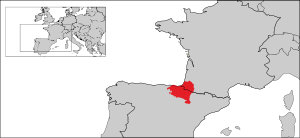
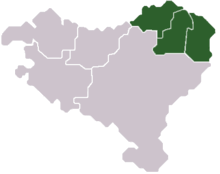
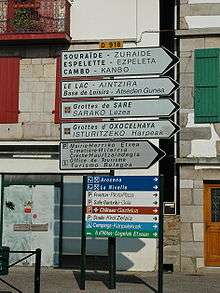
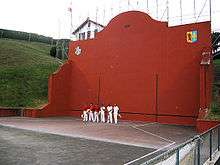
The French Basque Country or Northern Basque Country (French: Pays basque français, Spanish: País Vasco francés, Basque: Iparralde, i.e. "the North Side") is situated within the western part of the French department of the Pyrénées-Atlantiques and constitutes the north-eastern part of the Basque Country.
With 2,869 km², it is delimited in the north by the department of Landes, in the west by the Bay of Biscay, in the south by the Southern Basque Country and in the east by Béarn (although in the Bearnese village of Esquiule, Basque is spoken), which is the eastern part of the department. Bayonne and Biarritz (conglomeration BAB) are its chief towns. It is a popular tourist destination and is somewhat distinct from neighbouring parts of either France or the southern Basque Country, since it was not industrialized as Biscay or Gipuzkoa and remained agricultural and a beach destination.
Basques describe the northern Basque Country as the union of three "French provinces" in the northeast of the traditional Basque Country:
- Lower Navarre (Nafarroa Beherea in Basque, Basse-Navarre in French), until 1789 kingdom of Navarre (linked to the kings of France). 1,284 km².
- Labourd (Lapurdi in Basque). 800 km².
- Soule (Zuberoa in Basque). 785 km².
Its Basque name is Iparralde ("Northern Side") while the part of the Basque Country located in Spain is called Hegoalde ("Southern Side").
Its population has been: 126,493 (in 1801); 162,365 (1851); 226,749 (1979) (79% in Labourd, 13% in Lower Navarre, 8% in Soule); 259,850 (1990) (81%; 13%; 6% respectively); 262,000 (1999 census).
According to an inquiry of 2006,[1] 22.5% were bilinguals (French-Basque), 8.6% were French-speakers who understand Basque, and 68.9% were not Basque-speakers. But the results were very different in the three zones; in the inner land (Basse Navarre and Soule) 66.2% speak or understand Basque; in the coast (Labourd) the figure stands at 36.9% ; and in the B.A.B. urban zone (Bayonne-Anglet-Biarritz) only 14.2% speak or understand Basque (20% of the B.A.B. people can speak or understand the Gascon language). The proportion of French-Basque bilingual speakers fell from 26.4% in 1996 to 22.5% in 2006.
There is a Basque nationalist political movement, born in 1963 with the Embata mouvement (forbidden in 1974) and now with Abertzaleen Batasuna and others, which seeks a split of Pyrénées-Atlantiques into two French departments: Pays Basque and Béarn; some other nationalist parties are EAJ, EA and Batasuna which have a reduced, almost symbolic presence, especially when compared to the southern Basque Country. These political parties historically receive fewer than 15% of the votes in the district elections.
In the 1980s and 1990s, a paramilitary group called Iparretarrak (the northerners) used violence to seek independence; it has been inactive in recent years.
On January 29, 1997, the area was made an official "pays" of France under the name "Pays Basque", that is, a representative body promoting several activities, but without its own budget.
History


Antiquity
The present-day territory was inhabited by the Tarbelli and the Sibulates, tribal divisions of the Aquitani. When Caesar conquered Gaul he found all the region south and west of the Garonne inhabited by a people known as the Aquitani, who were not Celtic and are modernly regarded as Basques (see Aquitanian language). In the early Roman times, the region was first known as Aquitania, and later, when the name Aquitania was extended until the Loire river, as Novempopulania or Aquitania Tertia.
Middle Ages
After the Basque rebellions against Roman feudalism in the late 4th and 5th century, the area eventually formed part of the independent Duchy of Vasconia, a blur ethnic polity stretching south of the Garonne River that broke up from the 8th to 9th century following the Carolingian expansion, the pressure of Norman raids and feudalism. The County of Vasconia was created extending around the Adour River.
In this period northern Basques surely participated in the successive battles of Roncevaux against the Franks, in 778, 812 and 824. Count Sans Sancion detached from the Franks and became the independent commander of Vasconia, but got involved in the Carolingian dynastic wars over succession after taking over Bordeaux (844), supporting the young Pepin II to the throne of Aquitaine. He became Duke of Vasconia after submitting to Charles the Bald (851).
At this point, Basque language was losing ground to vulgar and written Latin and was increasingly confined to the lands around the Pyrénées. Since 963, the town Saint-Sever is mentioned as "caput vasconiae", interpreted by some as "limit of Vasconia", while others take it as "prominence of Vasconia" on account of its location on a hill overlooking the plains of Vasconia.
The lands to the south of the Adour became Labourd, encompassing initially a bigger region than the later territory around the Nive (Errobi) and the coast. In 1020 Gascony ceded its juridsiction over Labourd, then also including Lower Navarre, to Sancho the Great of Pamplona. This monarch made it a Viscounty in 1023. The area became disputed by the Angevin Dukes of Aquitaine until 1191 when Sancho the Wise and Richard Lionheart agreed to divide the country, Labourd remaining under Angevin sovereignty and Lower Navarre under Navarrese control.
Meanwhile, Soule (Zuberoa) was constituted as an independent viscounty, generally supported by Navarre against the pretensions of the Counts of Béarn, though at times also it admitted a certain Angevin overlordship.[2] With the end of the Hundred Years' War, Labourd and Soule passed to the Crown of France as autonomous provinces (pays d'êtat).
After the conquest of Upper Navarre by Castile in 1512–21, the still independent north-Pyrenean part of Navarre took the lead of the Huguenot party in the French Wars of Religion. In this time the Bible was first translated into the Basque language.[3] Eventually Henry III of Navarre became King of France but kept Navarre as a formally independent state, until in 1620–24 this separation was suppressed.
In 1634, Axular gives in his literary work Gero a rough description of the extent of Basque at the time, with the language comprising all the provinces now known as Basque Country "and [in] so many other places". After Axular's accomplished book, other Basque writing authors followed suit, especially in Labourd, a district thriving on whale hunting. In 1579 an important handbook for navigation was published by Martin Oihartzabal, the Navigational pilot offering guidance and useful landmarks found in Newfoundland and other Basque traditional fisheries. In 1677 it was translated to Basque by Pierre Etxeberri. However, during the 17 and 18th century that activity saw a gradual decline as the English took over from the Basques.
Modern Period

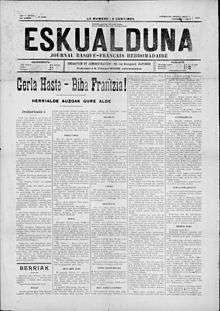
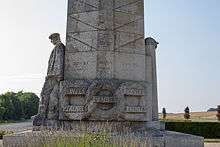
The three Northern Basque provinces still enjoyed great autonomy until the French Revolution suppressed it radically, as it did elsewhere in France, eventually creating the department of Basses-Pyrénées, half Basque and half Gascon (Bearn, a former sovereign territory). Third estate representatives of the Basques provinces attending the Estates-General of 1789 and the following national assemblies in Paris rejected the imposition of an alien political-administrative design, regarding the events with a blend of disbelief and indignation. The brothers Garat, representatives of Labourd, defended against a hostile audience the specificity of their province and that of the Basques, putting forward instead the establishment of a Basque department.[4] However, eventually the brothers Garat from Labourd voted for the new design out of hopes to get a say in future political decisions.
The three Basque provinces were then shaken by traumatic events after the intervention of the French Convention army during the War of the Pyrenees (1793–95). Besides prohibiting the native Basque language for public use ("fanaticism speaks Basque"), an indiscriminate mass-deportation of civilians followed resulting in the expulsion from their homes of thousands and a death toll of approx. 1,600 in Labourd.[5][6]
The Basques started to be forcibly recruited for the French army, with large numbers of youths in turn deciding to run away or defect among allegations of mistreatment, so starting a trend of exile and emigration to the Americas that was to last for more than a century. It became a matter of concern discussed by Napoleon Bonaparte and Dominique Garat. As of 1814, traditional cross-Pyrenean trade fell conspicuously, starting a period of economic stagnation. Eventually, trade across the Pyrénées border was cut off after the First Carlist War, with large numbers further departing to the Americas in search for a better life. In Soule, the emigration trend was mitigated by the establishment circa 1864 of a flourishing espadrille industry in Mauleon that attracted workers from Roncal and Aragon too. Others took to smuggling, a rising source of revenue.
The mid-1800s were years of decay and yearning for the good old times before the French Revolution. The Basques divided into Republicans, laicist Jacobins (but for a nuanced position held by Xaho), and Royalists (traditional Catholics), with the latter prevailing among the Basques.[7] Shepherding and small mining and agricultural exploitations were the main economic activities along with an increased presence of customs officials, both local and non-Basques.
The railway arrived at Hendaye in 1864 (Mauleon in 1880), increasing the flow of freight and people from outside the Basque Country that replaced especially on the coast native inhabitants by non-Basque population, with Biarritz as the most revealing case, in a colonie de peuplement type of settlement (Manex Goihenetxe, Eneko Bidegain). Elitist tourism gained momentum as of 1854 (Kanbo, Saint-Jean-de-Luz, Biarritz, Hendaye, etc.), as the high nobility (e.g. Eugenie de Montijo) chose to take healing baths in spa resorts and get close to nature.
In 1851, the first Lore Jokoak took place in Urruña (restored floral games tradition) organized by the scholar of Basque-Irish origin Antoine d'Abbadie (Anton Abbadia), followed by several more editions up to 1897. Other political and cultural events in fellow Basque districts to the south of the Pyrenees had an impact in the French Basque Country, especially in church related circles (periodicals like Eskualduna, 1887), the only institution that still spoke to the people in their language. That could not prevent Basque language from further receding to local and domestic circles. In 1914, Basque ceased to be the trading language with the local middle and higher class customers at the Mauleon marketplace (Soule).
The Basques could not avoid getting entangled in World War I when they were drafted to the front. While across the border Gipuzkoa and Biscay thrived on their shipbuilding and steel processing industry supplying the European war effort,[8] continental Basques under the age of 49 were required to the front of north-east France.[9] From the beginning and as the slaughter of the trenches wore on, thousands of Basques objected to military service, defected and fled to the south or the Americas.[10] However, war took a heavy toll, 6,000 died in the front, a 3% of the French Basque population.[11] It also produced the idea in the Basque psyche of being a component part of the French nation, fostered by the above weekly Eskualduna on the grounds that "God champions France."[12]
Culture
Northern Basques continue to practice many Basque cultural traditions. The town of Saint-Pée-sur-Nivelle is well known for its Herri Urrats celebration.[13]
Economy
The Northern Basque Country has 29,759 companies, 107 companies for 1,000 inhabitants and an annual growth of 4.5% (between 2004 and 2006).[14]
66.2% of companies are in the tertiary sector (services), 14.5% in the secondary sector (manufacturing) and 19.3% in the primary sector (mainly agriculture, agribusiness, fishing and forestry). This includes an AOC wine, Irouléguy AOC.
Although the Northern Basque Country is part of the Pyrénées-Atlantiques for most administrative entities, it does have its own Chamber of Commerce ( the CCI Bayonne-Pays-Basque) and a distinct economy with a pole of competences around the boardsports industry including companies such as Quiksilver and Volcom based on the Basque Coast.
See also
| Wikimedia Commons has media related to Northern Basque Country. |
- Aquitani
- Bayonne ham
- Duchy of Vasconia
- Izarra, a local liquor
- Eusko, local currency
- Kingdom of Navarre
References
- ↑ Fourth Sociolinguistic Survey. 2006: Basque Autonomous Community, Northern Basque Country, Navarre, Basque Country, Basque Government, Vitoria-Gasteiz, 2008, ISBN 978-84-457-2777-5.
- ↑ Baja Navarra y Zuberoa (La Historia y los Vascos – Vascon.Galeon.com)
- ↑ "Joanes Leizarraga Vida Y Obra" (PDF). Euskomedia. Retrieved 2008-01-28. Article in Spanish
- ↑ Bolinaga, Iñigo (2012). La alternativa Garat. Donostia-San Sebastián: Txertoa. pp. 50–53, 70–71. ISBN 978-84-7148-530-4.
- ↑ Etxegoien (Xamar), Juan Carlos (2009). The Country of Basque (2nd ed.). Pamplona-Iruñea, Spain: Pamiela. p. 23. ISBN 978-84-7681-478-9.
- ↑ Bolinaga, Iñigo. 2012, p. 87
- ↑ "Republicanismo en Euskal Herria: Iparralde". Auñamendi Entziklopedia. EuskoMedia. Retrieved 2015-05-16.
- ↑ "La economía vasca durante el período 1914-1918". Auñamendi Entziklopedia. EuskoMedia. Retrieved 2015-05-16.
- ↑ Bidegain, Eneko (2012). Lehen mundu gerra "Eskualduna" astekarian [World War I on the Weekly Euskalduna] (PDF). Universities UB/BU and UPV/EHU. p. 652. ISBN 978-84-8438-511-0. Retrieved 2015-05-16.
- ↑ Bidegain, Eneko. 2012, pp. 562-571
- ↑ Bidegain, Eneko. 2012, p. 174
- ↑ Bidegain, Eneko. 2012, pp. 606, 658-659
- ↑ "Celebration of Herri Urrats, traditional festival to help Basque language schools in the Northern Basque Country". Euskalkultura.com: Basque Heritage Worldwide (BETA). Retrieved 29 February 2012.
- ↑ "Invest Pays Basque". CCI Bayonne. Retrieved 2008-06-05. Invest-PaysBasque.com